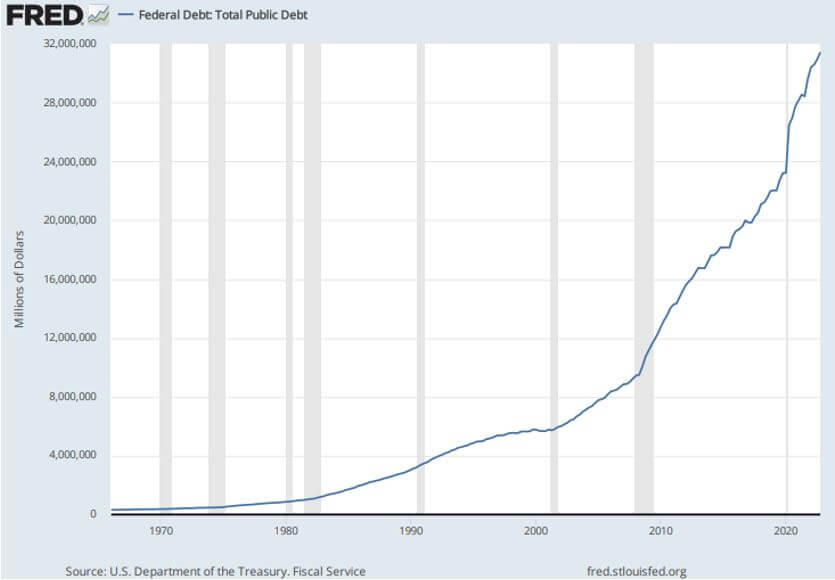
Our Investment Management team conducts extensive analysis of economic and market information to construct investment portfolios for our clients. To offer insights into their work, we are sharing some of the fascinating charts they review in our client newsletters, providing explanations of what the charts reveal.
The US debt ceiling is a cap on the total amount of allowable US federal debt. Fears about the debt ceiling surface every year and arise because the US government spends more than it receives in taxes. This means that the US has to continually increase the ceiling, otherwise it would be unable to meet its financial obligations.
This chart shows the increase in total US federal debt, which is otherwise known as their national debt. When the chart starts, in 1966, their total national debt was $320 billion. It is now $31.5 trillion, roughly 98 times greater. This is a staggering increase, although it is an overly simple and perhaps misleading way to looking at a country’s debts.
The US economy has grown from $815 billion in size in 1966, to $26 trillion today, an increase of 32 times. Therefore, the US national debt level, as a percentage of the size of the economy (GDP), has risen from around 39% to 121%, a more modest and manageable increase of 3 times.
The media spends a lot of time talking about debt, but rarely talks about assets and wealth. The ability for the US to service its debt is incredibly high, given the size of the US economy, the level of wealth and assets across the country, the strength of the US dollar, and the country’s high credit worthiness as the number one economy and military in the world.
Other less powerful developed countries have higher debt levels relative to the size of their economy. For example, Japan and Italy have national debt levels as a percentage of GDP of roughly 225% and 144% respectively.
The US hit their current debt ceiling again on 19th January and, as a result, the authorities have implemented a series of “extraordinary measures” to ensure they can still borrow in the interim until a new debt ceiling is agreed by the US Senate.
Since the 1960’s, the US debt ceiling has been raised, in some manner, 78 times in order to avoid default and to keep the government running. In recent days, the Republicans have pledged to vote in favour of raising the nation’s debt ceiling, although with the condition of capping future federal spending at 1% of GDP. This is an early indication that the opposition is willing to negotiate and an agreement between Democrats and Republicans is likely.
Should the legislation not pass, the fallout would be detrimental to the US economically and politically and could cause financial turmoil, which would mean some short-term volatility in client portfolios. However, the reality is that the legislation will eventually pass as it always does, despite any divisions in Washington – there is no other alternative!
The contents of this article are for information purposes only and do not constitute individual advice.
